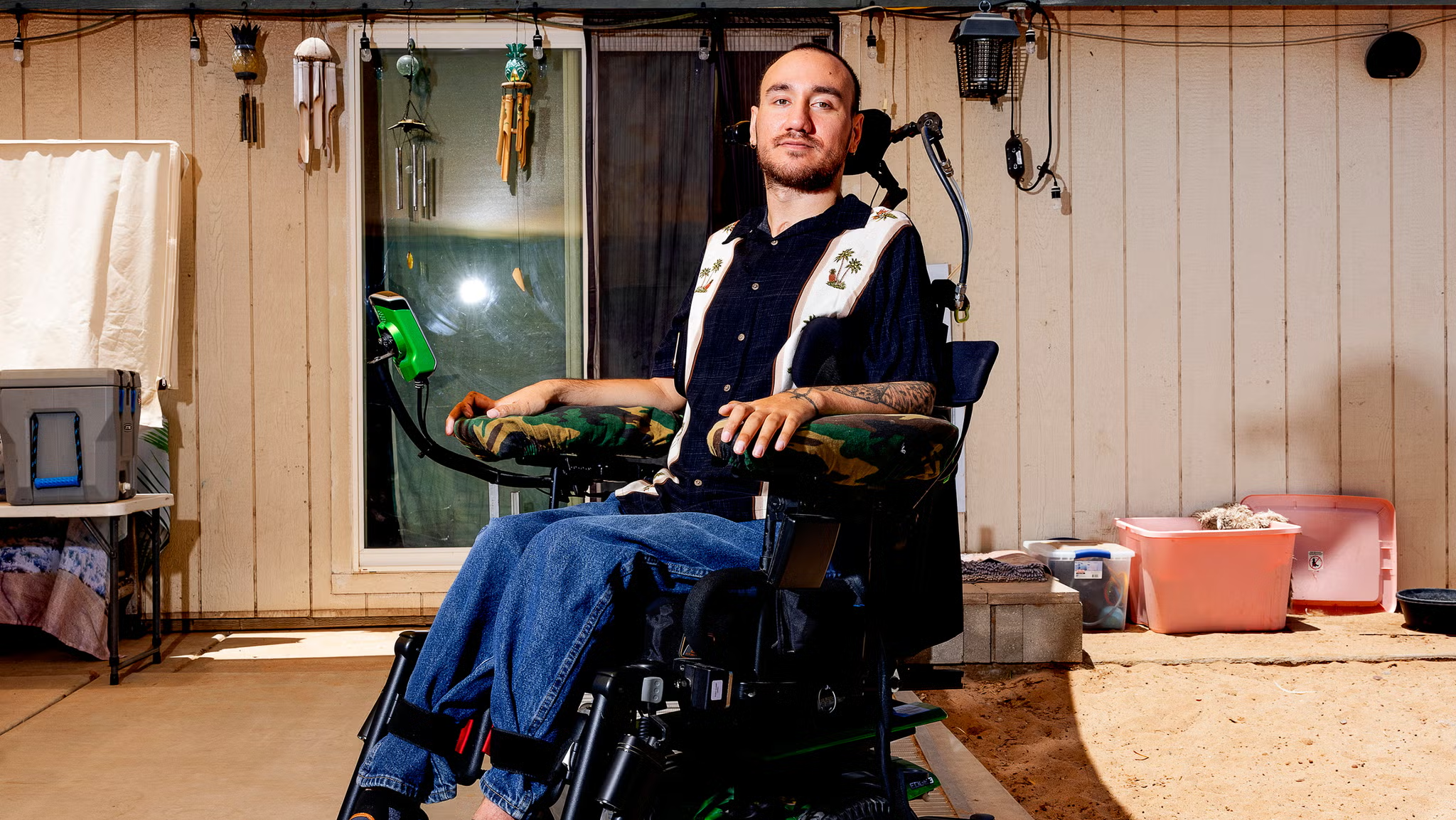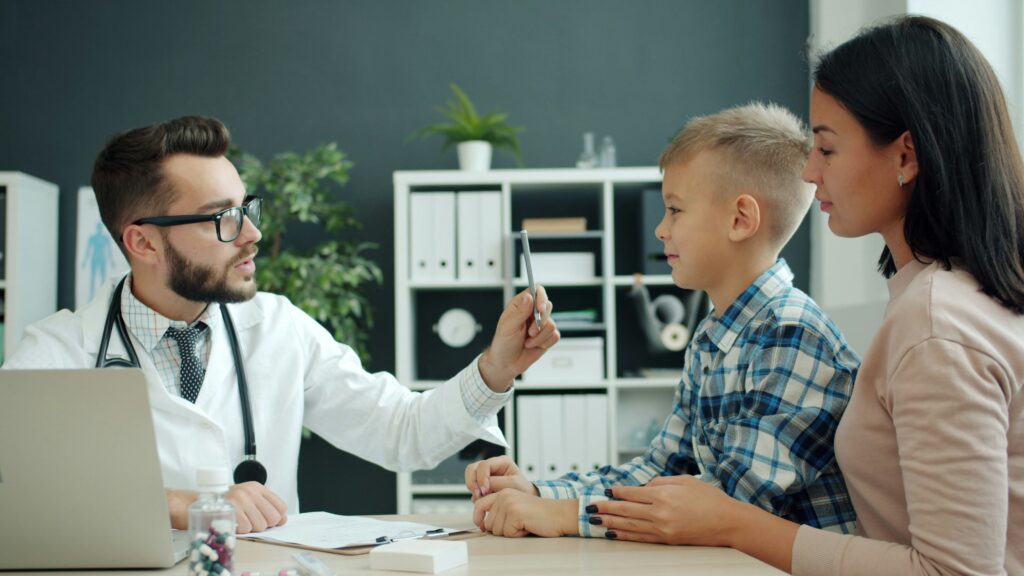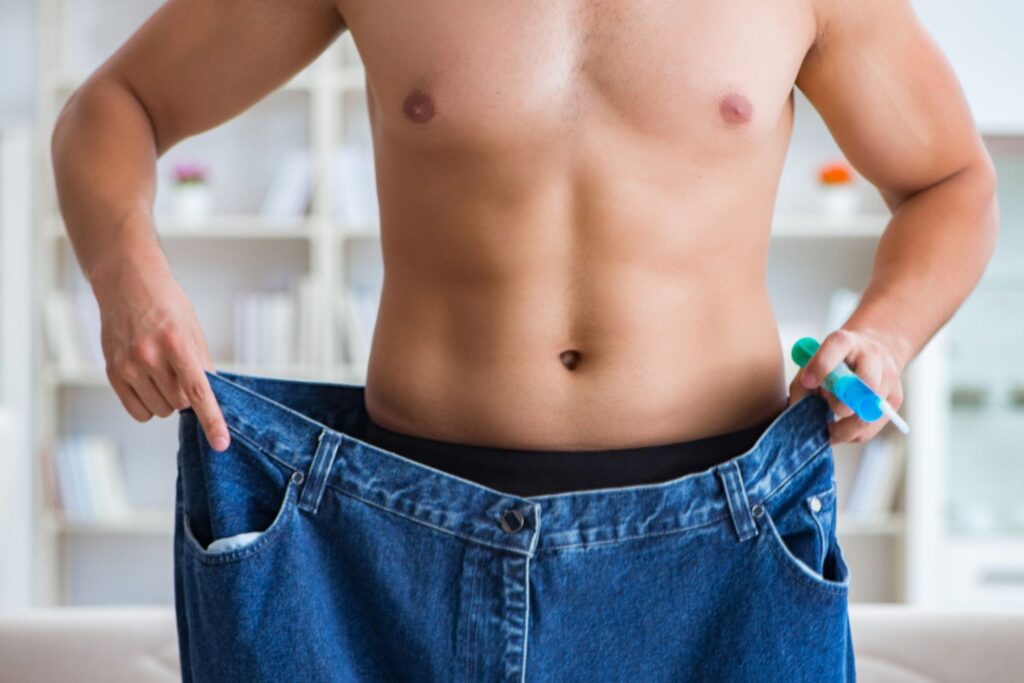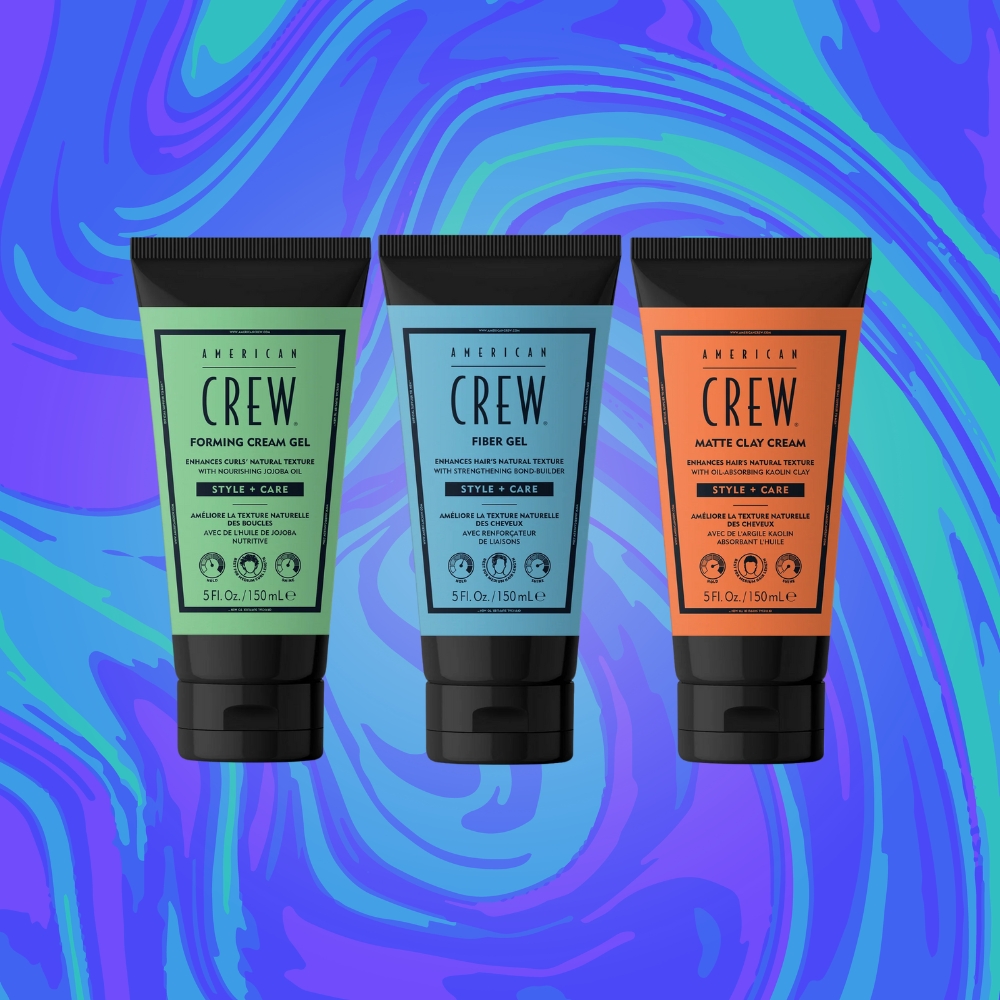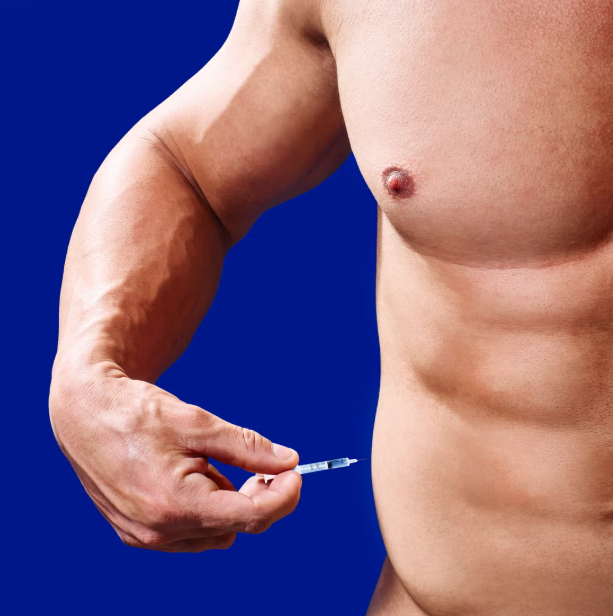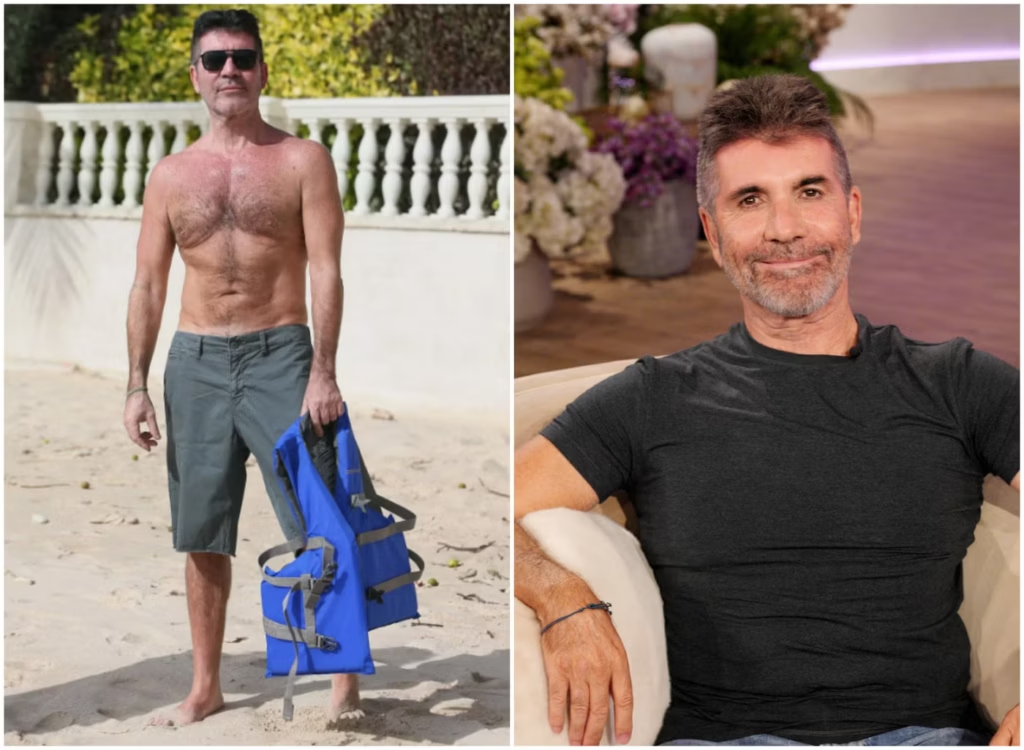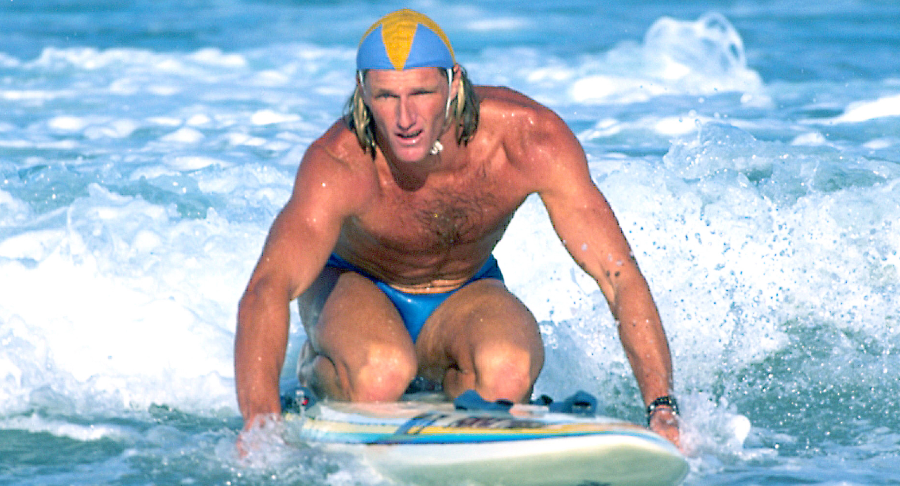NOLAND ARBAUGH SITS – always, he sits – in the kitchen of the ranch house on the sandy road in the sandy town of Yuma, Arizona, where he has lived since he was three years old. He lived here until he was 18 and went off to college at Texas A&M, and he swore he’d never live here again. He loves his parents – his mum, Mia, who raised five kids in this house, and his dad, David, who’s technically Noland’s stepfather, but he’s his dad. It’s just that Noland wanted to explore life on his own, create adventures, and not be the kid who moves back home. Even…even after he had his accident and lost all movement below his shoulders, he tried living at a friend’s house down the road, but that was just hard for everybody. His friend was just starting a job as a firefighter and he wasn’t around much. Mia was driving over to the house sometimes three times in the middle of the night to help Noland with one thing or another. It wasn’t working.
So, he came home.
In the kitchen, Mia – comfy in sweats, with bright saucer eyes, a ready smile, long brown hair, and an energy that’s much younger than her 55 years – holds a disk the size of a drink coaster to the spot on Noland’s head where the implant lives, under his black Carhartt beanie and his mop of brown hair and his scalp and his skull and the dura that protects his brain. The implant goes to sleep, like a computer, when it’s not in use, and someone has to hold the disk over it to wake it up.
Noland is talking to the cursor on his computer, even though it responds to the electrical signals in his brain, not his voice.
“Work,” he says to the Internet. A command.
A message appears on the screen: downloading update.
“Good Internet!” he says, like he’s talking to a puppy.
On many days, he sits in front of this computer for two or three hours, clicking and talking or videoing with a technician or an engineer from Neuralink, the company that manufactures a chip called the N1 and partnered with neurosurgeons at the Barrow Neurological Institute in Phoenix to implant it in Noland’s brain on January 28, 2024. The chip is a bit larger and thicker than a few quarters; it consists of a round battery, tiny round microchips, and threads—thin wires that sprout electrodes across them and fan out to the parts of Noland’s brain that control specific muscle movements in his body. His neural signals (i.e., thoughts) travel through the threads and into the implant, which sends them wirelessly to the Neuralink app on his computer, which then converts them to whatever action (moving a cursor, opening a file, sending an email) he intended. Neuralink developed a surgical robot to connect the threads to precise locations on his brain once the human surgeons drilled into his skull.

Noland (left) and his mum, Mia, in their home a few months after Noland received the implant.
Noland is Neuralink’s patient zero, its guinea pig, the first person to volunteer to allow a company owned by Elon Musk to put a chip in his brain. Nearly nine years into his life with quadriplegia and a little over a year into his life as a Neuralink patient, Noland and his family have felt their way into a kind of routine. After the bizarre and unthinkable happened, they did what you do: They molded their lives until they fit into this odd new existence, pushing and pulling on the parts that didn’t work until each day felt less like a bag of snakes and more like something they could manage. It’s what everyone has to do – manage – but for the Arbaughs, managing didn’t always seem possible.
Neuralink? That was desperation. That was why-the-heck-not. Brain chip? Okay! And yes, it changed things. Not everything, but things. Before the implant, Noland couldn’t send an email, couldn’t order food or stream a movie, couldn’t connect with other humans through online chess – couldn’t be alone for more than maybe 30 minutes without having to call someone for help.
“Yeah, that’s basically it,” Noland is saying. “I think where I want the cursor to go, and it goes.” When he first got the implant, he made what they called attempted movements: Even though he knew he couldn’t move his hand to control a mouse or a trackpad, he would think about attempting to move his hand right, left, up, down. The cursor’s movements were clunky, but it worked. Once he mastered that, they told him to stop attempting to move his hand and imagine his hand moving in those directions. Then they cut the hand out of the thought process altogether, and Noland was to think about the cursor moving: right, left, up, down. Move cursor right, he would think.
And the cursor would move.
“It did feel like magic at first,” he says. His voice is calm, a little droll. “The day I could just imagine moving the cursor, just thinking, Cursor, go here, that blew my mind. Like, this shouldn’t be happening. I was giddy for a whole day.”
It’s cool when other people see it for the first time, the cursor bouncing around the screen, clicking on icons and opening browser tabs and moving chess pieces, nothing controlling it but the thoughts in Noland’s head as his hands rest on his wheelchair, fingers unwittingly curled.
Because it is 2025, there are the cynics and trolls and bots and catfishers and rage farmers.
“People are like, ‘You let Elon Musk put a chip in your brain?’ ” Noland says.
“Oh, people are so skeptical,” Mia says. “You get all the naysayers who think he’s the Antichrist.”
Which is funny, because Noland is a devout Christian who leans on his faith to help him understand his postaccident life – and not just understand it but be pretty good with it. His religion, however, is not the only source of his strength, not by far. If any of us were so unlucky to suffer what he did, we should be so lucky as to have the positivity, strength, and optimism he has summoned over these last eight-plus years. It hasn’t been easy, and how he did it is a mystery worth untangling, a process more complex than robot-assisted neurosurgery.

THE ACCIDENT WAS on June 30, 2016. A tenth of a second, almost nine years ago.
Noland was a 22-year-old counsellor at a summer camp in the Poconos, in Pennsylvania, near the New York border. A little backwoods town, nothing but other summer camps for 50 miles, it felt like. He loved it there, loved being outdoors, leading activities with the kids. Noland played roller hockey growing up, played all kinds of sports, also bass guitar, acoustic guitar, saxophone. He was in a band in high school. Noland was never not doing something.
He and the other counsellors had a day off, and they drove up to a lake in Binghamton. Some of the girls were standing waist-deep in the water, and Noland and some guys ran into the lake toward the girls – to splash them, dunk them, maybe flirt, goof around. Something flicked Noland in the side of the head, a flying elbow, a stray knee, a gleeful fist – he’ll never know what it was, but it dropped him.
“Just a day-off, random, freak accident,” he says. “Got nicked in the side of the head in just the right way where it dislocated my neck at the C4, C5 perfectly and popped right back into place.”
Looking back, he has flashes of memories in the water after, when his friends were pulling him out. He recalls an ambulance, parked right there on the beach by the lake, but right away the paramedics called in a helicopter. He remembers flickers of the helicopter ride, and the lights on the ceiling of the hospital rushing over his head like streetlights as they wheeled the gurney down a hall.


A plaster mold of Noland’s brain (right), which shows the hole where the chip was implanted. The Neuralink team, including Musk, signed the mold.
By that time, Mia, who was back home in Yuma, was on the phone with a nurse at a small hospital in Binghamton. “I could hear people laughing – he was making them laugh,” she says. But that brief moment of Noland being Noland passed quickly as the paralysis seized his body. “From what they were telling me, his body started to react to the injury – from his waist all the way up to his spine was closing, closing, closing, like it was just suffocating him. And then I could hear him gasp, and he said, ‘I can’t breathe,’ and this nurse was like, ‘I gotta go.’ And I said, ‘Wait!’ But she told me they were taking him in for surgery.”
Mia and David drove the two-plus hours up to Phoenix Airport and took three flights over nine hours to get to their boy. “Every single person on every plane my husband and I were on was so comforting and trying to help, because I just was like, ‘I want to see him!’ I kept telling God, ‘You can take him – he’s yours anyways – but let me deliver him. Let me be the one to see him before you take him,’ ” Mia says. “And I was there when he first opened his eyes and took his first breath. He couldn’t talk. He was intubated. He just closed his eyes so tightly and cried, and I just said, ‘It’s okay.’ I took his hand. ‘Whatever is to come, I’m not leaving you.’ I felt the power of God, his big shoulders behind me.”
Noland was at the Binghamton hospital for a full week. Then he was transferred to Helen Hayes Hospital, an hour outside of New York City. That was another three weeks. When he was strong enough, he flew to Craig Hospital, near Denver, a traumatic brain injury and spinal cord injury center.
Mia left Yuma the day of the accident, leaving her work as the youth pastor at her church, and didn’t leave Noland’s side for four months.

THE CRISIS IS easier. No one tells you that. When the crisis is happening, you’re dealing with the crisis – receiving information, making a hundred decisions a day, learning about test results and vertebrae and neurons, and that’s all your mind can handle. There is no time even for comprehension of what’s happened, to say nothing of grief. Only later, after you’ve endured the life-or-death moments and come out barely on the side of life, do you allow the bad thoughts in. Thoughts of guilt and self-pity. Thoughts of desperate hope. Thoughts of the absence of hope.
And the worst of all: thoughts of permanence.
In the first months and even years after the accident, Noland would sometimes be up all night with an itch on his face that he couldn’t scratch. Or he needed water, or food, or the light was too bright. Many times he didn’t want to bother anyone, so he didn’t call out for help. And every time he didn’t, every time he chose to lie in silence, alone, the invisible tethers that connect him to the world, that connect all of us, frayed a little more.
His crew of friends would visit. “People always told me you might keep one friend from your childhood, one friend from high school – that’s about it,” he says. “But I’ve kept – jeez, 10 of us?” Still, even with those guys, conversations could be tough. They would tell him what they were up to, their jobs and trips and family stuff. What about you, they’d say? Oh, you know, he would say. He was talking less and less.
But his friends kept the ties strong. They bought equipment and gifts for Noland. They had a text chain with Mia, always asking what he needed, what she needed, what they could do. They chipped in and bought him an Xbox with a QuadStick, a specialised gaming controller for people with quadriplegia.
“And they sent him this great thing for drinking – we call it the giraffe!” Mia says.
“That’s what it’s called,” Noland says. “It’s called a Giraffe.”
“Oh.” Mia smiles and shrugs.
Mia set up a baby monitor to make it easier to tend to him, but that backfired – no one could sleep with all the little noises, and if Noland was on the phone with someone, Mia could hear everything.
But fun things started to happen again too. Neither Noland nor Mia had any tattoos before the accident, “but I decided, What better time to get a tattoo than when I can’t feel it?”
“He told me they put a chip in people’s brain that lets them control computers and stuff,” Noland says. “I was like, all right, sounds cool. Why not?”
“We have tattoo days,” Mia says. They found a guy who comes to the house.
“The first one we got was this one on my chest, a pineapple,” Noland says.
“I have a matching one on my back. It’s my spinal cord one for him,” Mia says.
Even though he couldn’t feel a needle injecting ink into his skin, his body was developing ways to tell him when something was wrong. He rarely knew what it was, only that he was sweating or that his heart was pounding.
“We can say something hurts or we don’t feel good, but when something’s bothering Noland, it’s already hurting him tenfold before he can actually feel it,” Mia says. “The catheter is a big one.”
“I have what’s called a suprapubic catheter, which means it’s always in. It’s an indwelling, below my belly button,” Noland says. Mia dabs the skin on Noland’s neck and left shoulder with a cloth, under his plaid flannel shirt – he’s sweating. “That’s what I’m almost positive is going on right now, some sort of blockage. Urine’s trying to get out, but it can’t, so my body’s freaking out. There might be a blood clot in there, or sediment buildup or something. That’s why I’m drinking this giant drink – we put lemonade in there, or cranberry juice, so maybe the acidity will break down some of that stuff. I also get blood clots pretty frequently because I have something inside my bladder that’s always pressing against the wall, and my bladder will get inflamed because that foreign object is in there poking around and it’s not happy. I’ve had a few clots that were gnarrrly, just ew, gross.”
Mia starts laughing – she has a deep, earthy voice and a carefree laugh. She’s from Samoa, and she decorates her home with paintings and photos of sunshine and beaches and ocean waves.
“We had a murder scene one time because a lady went in to do his catheter change, and she put the catheter in to blow up the balloon, but she put it in and blood just started squirting out like a faucet from his site! We were all laughing because he didn’t feel it! Just blood everywhere,” Mia says. “It turned out he had a UTI and she didn’t know, so his inside was inflamed and she nicked a wall when she went in. It was like a lot of blood.”
“So, yeah, these sorts of things just happen,” Noland says.
There were nurses early on, and overnight caregivers, but fewer and fewer as the years went by and the insurance company cut back the hours, and cut back the hours, and cut back the hours. The Arbaughs had always been a resourceful family, and they focused: David, who works in construction, kept looking for ways to rerig the old house to accommodate Noland’s evolving needs – widening doors, adding ramps. (The front door is still two steps up and requires a folding ramp.) You can still see metal studs around some of the doors, evidence of the measuring and Sawzalling and drilling and shimming – evidence of hours of work, and of a father’s love for his son.
While Mia continues to dab sweat from Noland’s left side, the right side of his body is cold and shivery. A Dyson heater whirs nearby to keep that side warm. “It’s a response to something that’s wrong in the body when you can’t tell physically,” Noland says.

Noland enters his home on the accessible ramp that was built for him postaccident.
“He passes out,” Mia says.
“Well, sometimes. I’ll get fevers; my blood pressure will get high. My heart rate will get high.”
“Scary high. Like 180 over 160.”
“Over 200. So you do a check. It could be something as simple as I’m sitting on something sharp and I don’t know it, and it’s creating a pressure sore. I can’t feel it, but it’s literally killing the tissue. Or when I wake up, having people help me and turn my body – any sort of movement after being in one position for so long sends me into a spasm. I have really bad spasms. I’m very spastic.”
“I’ll do spa days with him, and I’ll clip his toenails or I’ll be cleaning the dead skin off his feet, and his whole leg spasms. It reminds me of when you go to the doctor and they hit your kneecap to check your nerves. I’m just like, What in the world?”
“Can you wipe the back of my neck?”
He’s had physical therapy and occupational therapy, which can work wonders for quadriplegic people, improving circulation, strength, and joint health.
“But insurance won’t pay for it anymore,” Noland says. “They’ll send a physical therapist out for a few weeks, and the PT will have to report back, and if the insurance company doesn’t see significant improvement, they’ll cancel it.”
“And it’s crazy because we see improvement,” Mia says. “His spasms aren’t as bad when he has PT, and he doesn’t have pain. But they’re like, ‘Well, he still can’t walk!’ ”

ONE DAY IN September 2023, Noland’s buddy Greg from A&M called him and told him that the human trials for Neuralink had just opened up. It’s that new Elon Musk company, Greg said. Noland knew about Tesla and SpaceX, of course, but he had no idea what Greg was talking about.
“He told me they put a chip in people’s brain that lets them control computers and stuff,” Noland says. “I was like, All right, sounds cool. Why not?”
Greg sat on the phone with Noland, filling out the online application, asking questions and then typing in the answers. (Greg spelled “Arbaugh” wrong, which Noland still finds hilarious.) Noland had applied to a large database of studies for spinal cord injuries before and never heard back from any of them, and the idea that he would be accepted into a high-profile study like Neuralink’s seemed absurd to him. When the application asked what he wanted from the study, he told Greg to type, “An Iron Man suit!” His long-term goals: “To connect to the Matrix.” The whole thing was probably a waste of time – but hey, sure, he told Greg. Send it in.
“I heard back from them the next day,” Noland says.
Neuralink called again and again, scheduling more interviews, psychological testing, physical tests (like how much movement he had in his hands and arms), then more interviews. And then, four months after Noland and Greg filled out the application, Neuralink called again. It had chosen him to be the first patient.
Surgery was in two weeks.

“YOU DON’T HAVE to do that,” Noland says. “You’re not gonna be able to do it.”
“Yes, I am,” Mia says.
He is looking down his nose as she begins to clip the plastic tube near his mouth, which he uses to control his chair – sometimes it gets chewed up and gross and needs a trim. By either blowing into or sucking through the tube – hard puff, soft sip, etc. – he can move the chair, tilt it, turn it.
“I thought about the military as a career,” he is saying. “The Corps of Cadets at Texas A&M is one of the six senior military colleges. But around the time I had my accident, I was not engaging much with school anymore. I was planning on doing more traveling and being a – ”
He looks down.
“Mum. Nope. You’re not – ”
“Yes, I am, just finish talking.”
“Nope, you have to go farther in. Nope, farther up. Nope, farther up. Nope. Over the green part.”
She moves the clippers up an inch.
“Like here?”
“Yeah. Sure. Thank you.”
“I think it’s about understanding that things could be better, and you want things to be better – but you know that they’re not, and you are at peace with that.”
Mia, in a mocking voice: “ ‘You’re not gonna be able to do it.’ ”
“So anyway, I was planning on being a traveling gypsy for a while. The summer camp hires a lot of people internationally and across the United States, so I had friends all over the world. I was planning on couch surfing.”
“And he was a horrible student.”
“I was a terrible student.”
“Terrible student.”
He bartended, made good money, and left A&M after four years, a couple of credits shy of graduating – the plan was to do a fifth year. He would still like to. “I’ve been talking to Texas A&M about going back, but they’re being squirrelly about letting me back in,” he says. “So I’m just going to try to get my transcripts and take some classes at a community college here and see if I can do it.”
Mia puts down the clippers, crosses her legs, and leans forward. She and Noland have been talking for more than an hour. He can sense when his mother is going to say something. He watches her.
“I will tell you something above everything else that you should know, which is that we are super grounded in our faith,” she says. “I’ve had people interview me, and they want to twist it around and ask me the same question 10 times. They’re like, ‘But how are you like this? You must have been so angry! You must want to blame something? You can’t be like this all the time, right?’ But I can be, because of my faith and because I love Jesus. Without him, I would probably be a broken person in the corner sucking my thumb, like, ‘What am I gonna do?’ ”
People ask, What God would do this?
“Oh, we get that a lot,” Mia says. “I just go back to my belief that nothing about God is not good. He turns everything into good. I know that God created me to be his mum and him to be my son, from the womb until the day it happened. No matter if we get angry and Noly says, ‘Get the heck out of my room,’ or I say, ‘I don’t wanna talk to you’ – we know that we love each other, and we’ll be fine in five minutes or the next day. We’ve always had that.”
She nods at what she is saying, looks at her son.
“I’m not saying it was easy. It took years for us to learn to communicate on a deeper level after his accident.”
A moment passes between them. They have an easy way with each other, and she stops speaking, as if ceding the floor to him. He is looking down, and he speaks carefully.

Noland in front of the Barrow Neurological Institute in Phoenix, when he was released from the hospital a day after surgery.
“The problem of pain, with God, is a difficult one for people to come to terms with,” he says. “The problem of grief and ‘why me?’ in these situations – it’s difficult. Why does God allow pain? There are people who say nothing from God is bad, it’s not God that does all of this, it was the fall of man, Adam brought evil and sickness and sin into the world, and we’re just living with the consequences of our decision to pull away from God. That’s the easy answer. I think it’s more complicated than that.
“There’s a famous quadriplegic lady, Joni Eareckson Tada. I remember an interview someone sent me of her saying basically, I am content with this life, and you have to find your contentment in life, and complete acceptance of your situation. For years I thought that was impossible for a quadriplegic, because the instant you ask them, ‘Wouldn’t you rather not be handicapped?’ they’re going to answer yes – and then people say, ‘Oh, so you’re not content.’ But that’s not the right logical flow of things. I think it’s about understanding that things could be better, and you want things to be better – but you know that they’re not, and you are at peace with that. Everyone imagines that if things were different, their life would be better, but I’m not necessarily sure that’s true.
“Even with me, if I wasn’t a quadriplegic, would things be better? They’d be better in certain ways, but would they be better in other ways?
“It took years to be able to understand that there’s a purpose for this, and I’m okay that I’m like this, and as much as it sucks, and as much as I wish I wasn’t, I’m going to move forward with a newfound joy, and peace, and purpose, because I know that whatever reason that I’m in this situation, I can only control my attitude, my decisions, and what I do. I can try to make my life as good as possible by my own hands. With God, I think a lot of things become possible. God wants me to be healed, he doesn’t want me to be paralyzed or sick, he doesn’t want that on anyone, but he allows these things because they strengthen us and mature us in ways that being healed instantly would have never done. He allows us to go through these things because ultimately it brings us closer to him, and it brings more glory to him, and that’s what we’re here for. We’re not here to live perfect, healthy, easy lives. We’re here to glorify God and find enjoyment in him to the best of our ability, and to try for that.”
Mia mops her son’s damp neck and gently uncurls the fingers on his left hand. She holds the straw of his massive drinking cup to his lips, and he swallows the cranberry drink.
“I still haven’t quite figured it all out,” he says, “but I’m on a better path than I was on five years ago.”

EVERY DAY, NOLAND logs on to Neuralink and does what they call a tune calibration.
Here’s how he explains it: The implant is a BCI, or brain-computer interface, and everything it can do begins in the brain. (These kinds of devices have been around for decades, none are FDA-approved for commercial use, and they’re all still in the experimental phase.) The brain is “plastic,” and the way neurons fire one day can differ ever so slightly from the way they fire the next—and when he boots up the computer each morning, the cursor behaves according to yesterday. So he spends maybe a half hour recalibrating the cursor.
It’s like a game: On his computer screen, a yellow dot appears on a black background.
With his brain, he moves the cursor across the screen to the dot in a janky line.
Then a blue dot appears.
He moves the cursor to the dot in a less janky line.
And so on, refining the movement to each new dot until the lines aren’t janky at all – straight, beautiful lines from Noland’s brain through the threads into the N1 chip to the cursor to the line to the dot on his screen.
Over these past 14 months, it’s gotten better and better and better. First he could left-click – that was hard, but he got it. Then he could right-click. He learned to zoom in, zoom out. Scroll up, scroll down.

Noland uses the BCI to connect to his computer and play chess.
Clicking and dragging is still tricky. It turns out to be a complicated task for the brain to master. Noland has spent hours with people from Neuralink developing work-arounds to try to replicate a click-and-drag, with varying success. It’s a lot of time, and the whole study is voluntary, but Noland takes his participation seriously.
“When we have experiments to run, we’ll get on a Google Meet for a few hours every day,” he says. “They’ll change software, change things on the app. They’ll ask me to do this with the cursor for 5 minutes, then do that for 15 minutes – we’ll repeat that experiment a dozen times and then run the numbers against each other.”
To send an email or a text, or to write in his personal diary, he uses dictation software – Siri, usually, though Neuralink built him a dictation program. The company has tried to invent ways he can write on the computer without dictation, using the chip, “like I’m imagining holding a pen and writing on a piece of paper. It was better than what previous BCIs were able to achieve, but it wasn’t good enough for our standard. Ultimately you would like to be able to think keys, or characters, or even whole words, and have it output. And I think that’s possible.” (Before Neuralink, Noland would sometimes have to edit a text message using Siri 5 or 10 times before it could get it right, and sometimes he would give up.)
Noland depends on Apple’s Siri app, and most of the Neuralink work is done using Apple products, he says. This almost became a problem in June 2024 when Musk declared on X that if Apple (which he considers a rival) were to integrate OpenAI (which he also considers a rival) into its operating system, Musk would ban Apple products from all of his companies…including Neuralink. “Everyone was freaking out,” Noland says. (The ban didn’t happen.)

Another view of the molds, which Noland keeps in his room.
Since the surgery, Mia has felt more freedom to leave Noland alone for longer periods of time. First, just going to the store, then longer outings, like celebrating her anniversary with David. Then their annual weekend hunting trip. And even at home, they’ve found more and more ways to leave Noland alone – in a good way. She and David bring a TV outside for him sometimes, so he can play video games in the backyard. The family keeps a Nigerian dwarf goat, quails, ducks, chickens, and a turkey, plus Gracie, a goldendoodle – there is life to this place, and company for him.
In his room: the hospital bed he sleeps in, plus a Hoyer lift to raise and lower him. His computer, a TV mounted on the wall, his Alexa cube, for controlling everything, including the ceiling fan. Leo, his tortoise. On the shelf: a plaster mold of his brain, which the neurosurgeons and the surgical robot practiced on—there’s a hole in it through which the implant was implanted. The whole team at Neuralink signed the mold, including Musk.
Two other patients received the N1 implant after Noland, but their identities aren’t public. Musk, who has a history of making overblown projections, has written on X that Neuralink intends to perform the surgery on “20 or 30” more people this year. However, in February it was reported that the Department of Government Efficiency, the quasi-government thing he runs, fired all the FDA employees who were overseeing the clinical trials for Neuralink (though some are now being asked to return).
Noland and his parents know that some people contend that Musk’s deeper, darker goal is not to help people with spinal cord injuries but to control the brains of the human race. People write or tweet or even say to Noland’s face that Neuralink can probably read his mind and control his thoughts. “But here you are interviewing us – there’s nobody else around him here, right? It’s not like the Wizard of Oz is over there behind the curtain,” Mia says. “Sure, Neuralink can see that he’s on the computer, but they certainly don’t tell him what to do – and they can’t read his thoughts! Some people are idiots. They just don’t know. They don’t read.”
“Sure, Neuralink can see that he’s on the computer, but they certainly don’t tell him what to do – and they can’t read his thoughts! Some people are idiots. They just don’t know. They don’t read.”
– Mia
Noland was never asked to sign a nondisclosure agreement with the company. It offered no media training and has placed no restrictions on what he can or can’t say. He has met Musk a couple of times but has no real relationship with him. Recently, at Donald Trump’s inauguration as president, Musk made an odd, stiff-armed gesture that many people interpreted as a Nazi salute and many other people did not.
“I did see the thing at the inauguration. I think I’m more pro Elon Musk, but as it is with everyone in the public sphere, everyone’s human, we all make mistakes, no one’s perfect, and there’s no sense in hero-worshiping or idolizing these people,” Noland says. “I posted once that he’s a personal hero of mine only because he’s had this desire to help with Neuralink with someone like me, and that has changed my life, so that makes me appreciate him in a very specific way. But you don’t know these people. Why would you wholeheartedly support anyone you don’t know personally? You could support him like I do and try to be positive and optimistic about everything that they do. But ultimately, I don’t know his desire or his heart or the intention behind everything he does.”
He turns to Mia.
“Can I have some tea?”
Was that a Nazi salute? At the inauguration?
“I think he just moves awkwardly. In general, I think he’s a pretty good dude. I have my flaws, and Elon Musk has his flaws. It is what it is, but I’ve liked the interactions I’ve had with him, and I can appreciate him on a deep level for the things he’s given me and the things he’s done for me. Milk and sugar, please? I think he’s one of the most brilliant men of our generation.”
With the first year of the trial behind him, Noland will continue the experimental sessions with Neuralink and use the chip on his own. He’ll have medical checkups every three months. He can opt out at any time – chip removed, study over. He will always be P1, as Neuralink calls its first patient. P2 and P3 are out there, and they might come forward and they might not. “As this grows, though, it will always come back to Noland Arbaugh,” Mia says.

Noland’s mom, Mia, and his stepfather, David, use a Hoyer lift to help him into his bed.
“I don’t think it needs to,” Noland says quietly.
Mia watches him, knowing there is more.
“I don’t really care if I’m the face of Neuralink. I don’t care if people remember me or my name. If tomorrow they decided they were going in a different direction, I’d say, ‘Thanks for having me. I had a really good time doing all of this. I appreciate everything you guys have done for me.’ If I can keep doing it, I will do it to the best of my ability,” he says.
Just then, he inhales quickly through his nose, a jerking motion that looks involuntary. He snorts. He moves his head around as if trying to crack his neck, looks up at the ceiling. Then his head settles.
“I’m still a quadriplegic. I still have to deal with my body, have to take care of myself. Neuralink is a bonus,” he says. “If our partnership gets to a point where they decide it doesn’t work anymore for whatever reason, then it doesn’t work. I had a good run.”
These are the things Noland Arbaugh tells himself. That if Neuralink were for some reason to want to end the trial for him, it would be fine. That God is good. That he accepts his lot in life. It’s not that he doesn’t believe these assertions—he does, to his core. But saying them, sometimes even repeating them a few times during this midday conversation, visibly emboldens him. Because you see him, and you hear him, and you can’t believe how well he’s doing, how assured, how positive, how content—how even happy—he is, and you shake your head in disbelief until you untangle it. Noland isn’t convincing himself of anything. He’s reminding himself: that if the trial ended, it would be fine, that God is good, that the past is past, that friends and family matter now more than ever.
It’s not always easy, this work of training his thoughts on the supports that shore him up. But it’s pretty brilliant, the way he is getting through life: God. Science. People.
Mia straightens his fingers one at a time, then she sits down. She smiles at her son, and there is pain behind her eyes, even amid the pictures of sunshine and ocean waves and the warmth of her face. She raises her eyebrows and shakes her head almost imperceptibly.
“We’ve had broken days, believe me. I walk out of his room sometimes and I cry,” she says. She pauses, then adds: “Because the things that he could do!”
Does Noland cry? He says he can’t remember the last time. He’s trying to remember, his brow furrowed – why can’t he think of it? There were times early on, for sure. Late at night, when the thoughts of uncertainty and permanence and the guilt over what he was putting his family through were crushing, and even though they were sleeping in the next room and would have jumped out of bed even to scratch an itch on his head, he never felt so alone in his life.
He remembers now! It was just a few months ago. He didn’t think of it at first, because these were tears of joy, not sadness. They had set up a GoFundMe to try to raise some money to help with medical expenses and things for the house, and the number of donations that came in from people, strangers and friends – well, it was overwhelming. And Noland cried tears of joy at how good this world can be.
This article originally appeared on Men’s Health US.




